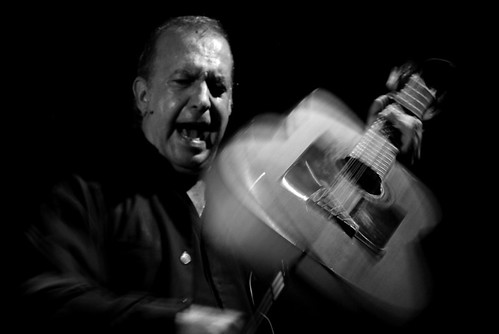
Papawa, originally uploaded by Sergi Forns.
Tangos is a flamenco palo closely related in form and feeling to the Rumba. It is often performed as a finale to a Tientos. Its compass and llamada are the same as that of the Farruca and share the Farruca's lively nature. However, Tangos is normally performed in the A Phrygian mode.
Tangos is distinct from the Rumba primarily through the guitar playing. In Rumba the guitar flows more freely, whereas in Tangos the accents on beats 2, 3 & 4 are marked clearly with heavy strumming.
Tangos flamenco is only vaguely related to Argentine Tango, probably sharing a common ancestor, besides compás binario or double stroke rhythm. The fact that Argentine Tango is one of the first couple dances in America has led some to believe that both could be based in a minuet-style european dance.
Early tango was known as tango criollo, or simply tango. Today, there are many tango dance styles, including Argentine Tango, Uruguayan Tango, Ballroom tango (American and International styles), Finnish tango and vintage tangos. What many consider to be the authentic tango is that closest to that originally danced in Argentina and Uruguay, though other types of tango have developed into mature dances in their own right.
There are a number of theories about the origin of the word "tango" in Argentina. One of the more popular in recent years has been that it came from the Niger Congo languages of Africa. Another theory is that the word "tango", already in common use in Andalusia to describe a style of music, lent its name to a completely different style of music in Argentina and Uruguay.
Tangos
Provenance: Cádiz, Málaga, Sevilla
Song with a 'copla' of three or four , eight syllable, verses. Considered one of the basic styles of flamenco, the 'tango' has varies styles, amongst which those of Cádiz, Triana, Jerez and Málaga stand out. All the theories indicate that the cradle of the 'tango' has to be split between Cádiz and Sevilla, ruling out any relation with the 'tango' from Argentina. It is possible that they came from the old danceable songs of the XIX century and bit by bit they where transformed into what we now know, a song executed in 4/4 in all possible tonalities. For example, 'los del Titi de Triana' executed in minor tones, those of Cádiz are acompanied by modal tones and those of Málaga or 'del Piyayo' in major tones. Granada also has its style that is executed 'por arriba' to a slower rhythm. The first artists known to perform it were; El Mellizo and Aurelio Sellés in Cádiz, Pastora Pavón and El Titi in Sevilla, Frijones and El Mojama in Jerez, and La Pirula, La Repompa and El Piyayo in Málaga.
To listen to the items, click on the icon
Download
Download
Download
Download
Download
Download
Milonga
Provenance: Cádiz
According to the majority of the experts, this song comes from Argentinean folk music, specifically from a song of Rio de la Plata, for which reason it is the 'ida y vuelta' style. It came into Andalucía by means of the port of Cádiz. It seems, Josefa Díaz, daughter of the bullfighter Paco Oro, was hired by Juan Junquera from Jerez to do a tour in Argentina. On returning Pepa Oro had adapted the 'milonga' offering it as the first of her repertoire. It usually has the rhythm of a 'tanguillo' and is executed in minor tones. Pepe Marchena was also one of its principal authors.
To listen to the items, click on the icon
Download
Tanguillos
Provenance: Cádiz
Song with a 'copla' that admits any measure. It is genuinely from Cádiz, for which reason it is also known as the 'tanguillo from Cádiz'. Its words are nearly always festive, joking and of little importance and are usually performed in the carnival. Its tempo is quicker than that of the tango, to which it is related in flamenco and Perico and Cano Lobato stand out in its execution.
To listen to the items, click on the icon
Download

No comments:
Post a Comment